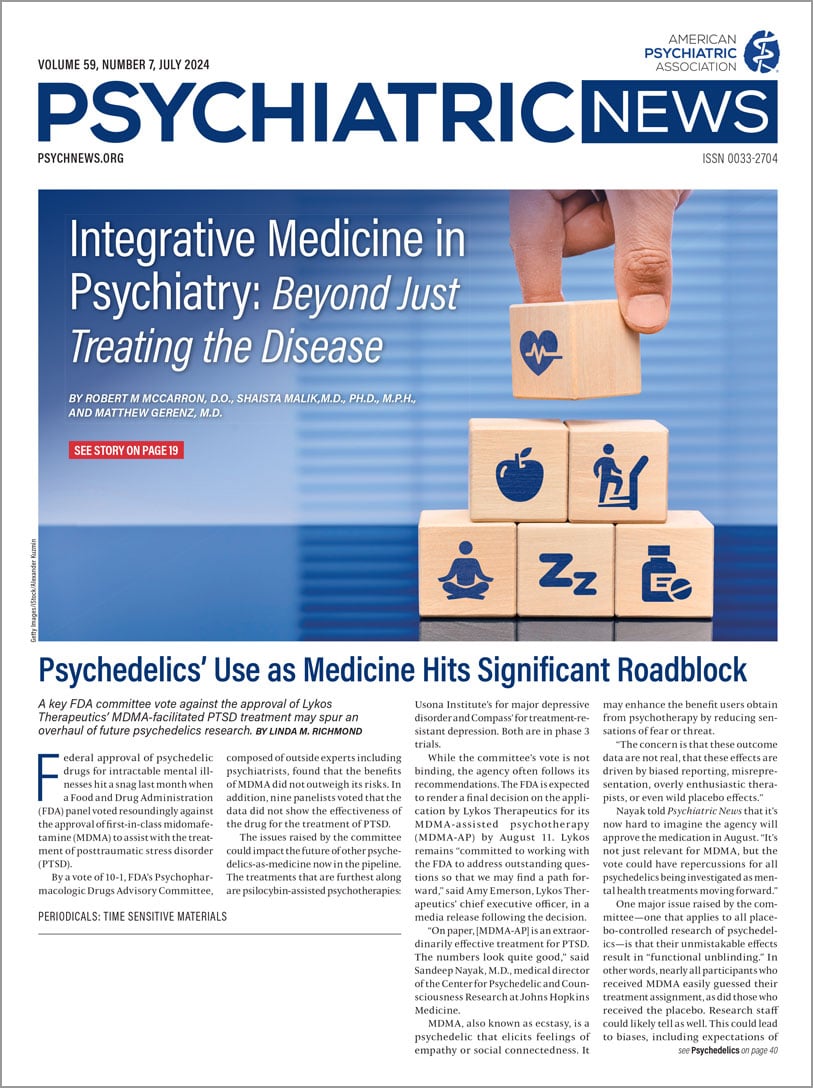A large health system in northern California adopted a validated suicide screener, resulting in better identification of those at risk and improved rates of psychiatric follow-up care, according to a recent
study in
Psychiatric Research and Clinical Practice.
Sutter Health began using the Columbia Suicide Severity Rating Scale, triage version (C-SSRS), because suicidality and behavioral health problems are pervasive in acute care settings, lead author Ellis C. Dillon, Ph.D., an assistant professor of public health services at the UConn Center on Aging, told Psychiatric News. The C-SSRS was chosen in part because it allows for a quick initial screening and more in-depth assessment of those who screen positive with another related tool, he added.
Sutter had previously been using the unvalidated “danger-to-self” (DTS) query. For that assessment, triage staff, typically nurses, used their judgment and recorded “yes” or “no” on whether a patient expressed suicidal thoughts or displayed other suicidal or self-harm behaviors.
About 9,000 acute care registered nurses who conduct triage completed 20-minute training sessions, while behavioral health nurses and clinicians completed a more in-depth one-hour classroom training. After a pilot program in three departments, Sutter rolled out the validated screener across its 23 hospitals in July 2019 for all acute-care patients aged 10 and up, regardless of their diagnosis.
In so doing, Sutter exceeded Joint Commission standards requiring the use of a validated screener for suicidal ideation only for patients 12 and up who are in psychiatric hospitals or for whom behavioral health conditions are their primary reason for care. “Organizations should adopt a validated suicide screener for all patients, regardless of the setting,” Kelly Posner Gerstenhaber, Ph.D., co-developer of the C-SSRS, told Psychiatric News. Gerstenhaber is a professor of psychiatry at Columbia University and founder and director of the Columbia Lighthouse Project.
“Many people who struggle with suicidal thoughts suffer in silence and don’t seek help from traditional mental health services. We need to find or meet people where they are to increase our chances of saving them,” she added.
The C-SSRS triage version includes up to six pointed questions about suicidal thoughts, intent, and planning and whether the patient has engaged in any suicide preparation within the past couple of months or at any point in the past. “It allowed us to better identify and categorize those who are at risk for suicide,” Dillon said.
He and colleagues studied Sutter’s results among adult patients for the first 18 months after they began using the C-SSRS screener and reported the following:
•
2.2% of patients were identified as at-risk for suicide with C-SSRS (1.3% categorized as “moderate” or “high risk” for suicide while 0.9% were low risk), up from 1.5% of patients who screened positive with DTS.
•
66% of patients deemed “moderate” or “high” risk for suicide received documented psychiatric follow-up care within 90 days, a slight increase from the 64% of those deemed at-risk with DTS who received such care.
•
11% of individuals with major depressive disorder (MDD) were found to be at-risk for suicide with C-SSRS, an increase from the 9% who screened positive with DTS.
Rate of Screening Drops
The switch to a validated screener also came with a challenge: a significant drop in the overall rate of screening (85% of all patients with C-SSRS, compared with 93% with DTS). “Some nurses were not comfortable asking the screener’s questions, out of concern that it might be triggering to the patient, which is a myth,” Dillon said. “As we continue to reduce and even eliminate stigma of mental illness, we still have a lot of work to do.”
Other potential factors include the additional time required for staff to complete the C-SSRS, patient refusals, and researchers’ decision to exclude all records with incomplete answers to the screener, Dillon said. He and colleagues called for more research on clinician and patient experience with the screening to identify barriers and determine the expected rate of screening in a general population.
Since the study’s end in 2020, Sutter has continued to monitor the utilization rates for the C-SSRS and has provided ongoing training to staff, Ernell De Vera, R.N., M.B.A., Sutter Health’s chief nurse executive for Mental Health and Addiction Care, told Psychiatric News via e-mail. “The number of people screened monthly has continued to increase since 2020.”
Sutter has also undertaken a review of its environmental risk assessment to identify and replace potential ligature or other self-harm items at its hospitals, De Vera added. It has also enhanced training on the role of staff in the monitoring of patients at risk for suicide, which it provides on a regular basis as well as to all new hires.
Changing Attitudes on Screening
When it comes to improving screening rates, Gerstenhaber said changing attitudes starts from the top. “Leadership support and commitment are essential to creating a culture where suicide prevention is prioritized. Acknowledging and alleviating fears about suicide and improving understanding of screening tools are part of that.” She gave the following additional tips:
•
Foster an environment in which staff feel empowered and encouraged to conduct screenings.
•
Provide comprehensive training programs, ongoing education, and clear communication of the importance of suicide risk assessment.
•
Conduct regular audits and provide feedback on results to help reinforce the significance of using the screener and to ensure adherence to protocols.
“People who are thinking about suicide actually want help, they want relief, but they don’t always have the will to seek it. Asking about suicidality relieves distress,” Gerstenhaber said.
This study was funded by Janssen Scientific Affairs, LLC. ■

